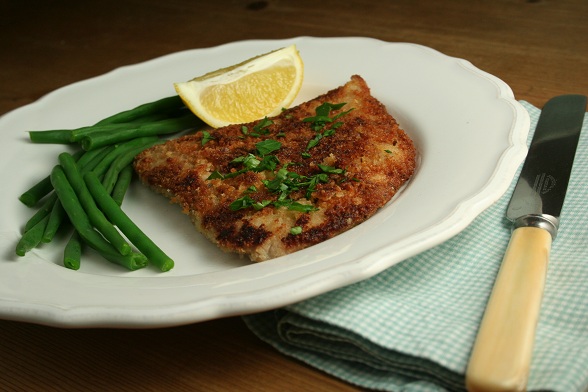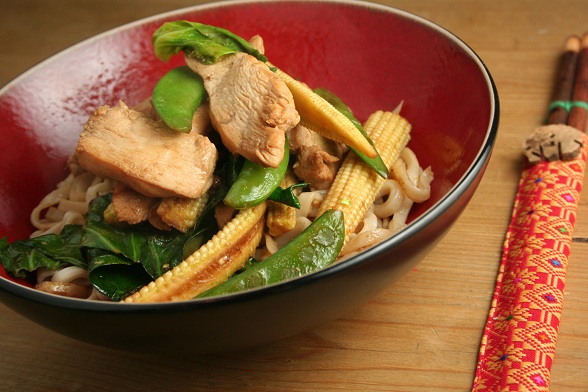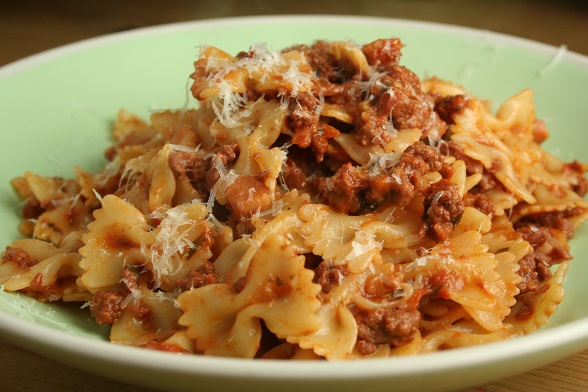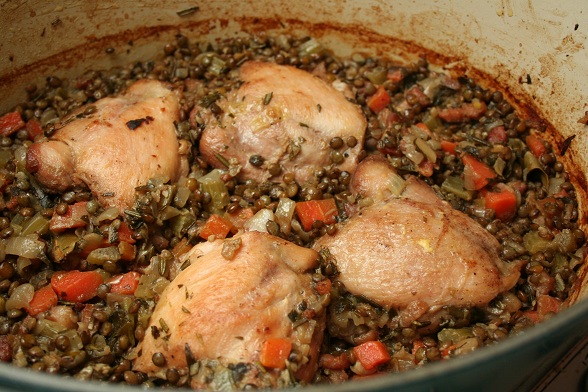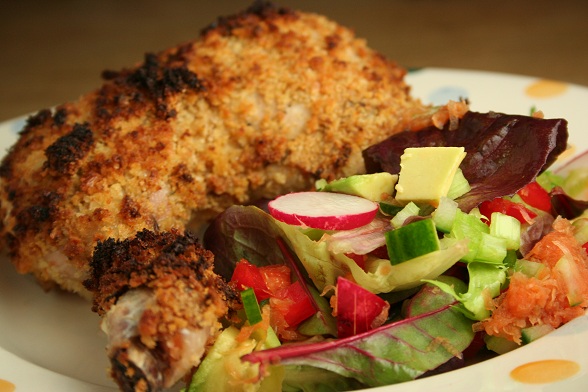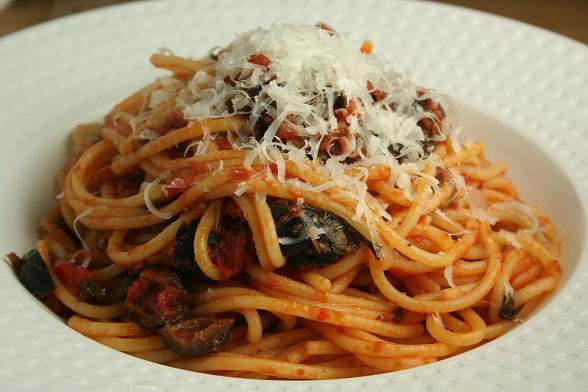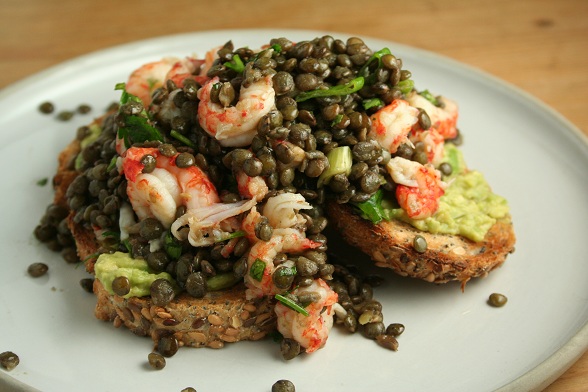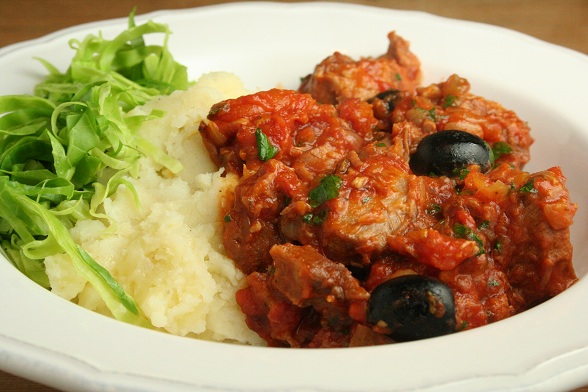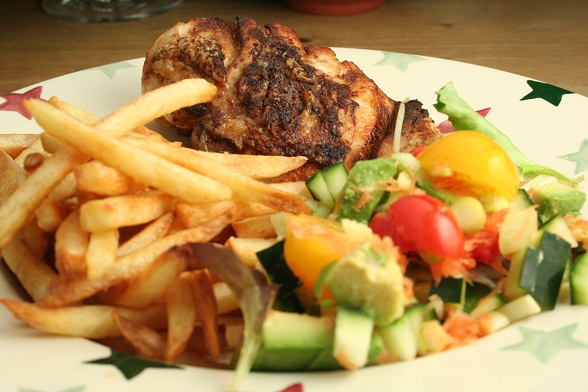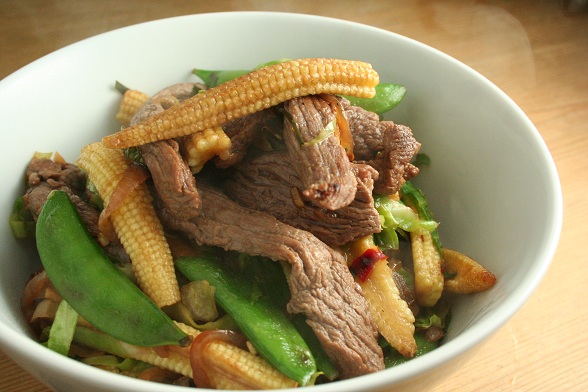Breaded Veal
This was going to be veal milanese (breaded veal, coated in egg, herbs and parmesan then rolled in breadcrumbs) but I didn’t have any eggs. Instead, I coated the veal with mustard (much like last Friday’s chicken), sprinkled on some dried herbs de provence (Stephen chopped some fresh parsley too but I forgot it ), some salt and pepper and then rolled it in breadcrumbs. We then fried the breaded veal in some oil and served it with some lemony green beans.
Not veal milanese but very good nonetheless, as everything coated in herbs and fried is.



Chicken Stir-Fry with Szechuan (aka Sichuan) Pepper
When we fancy a stir fry of some sort we usually end up following a Thai recipe or at least giving it a Thai twist, but this time we fancied something in a Chinese style instead. We had intended to use oyster sauce but when it came to cooking time we found that we didn’t have any. Problem. And we thought of using chilli flakes but we found that we had none of those either. Another problem. But we ended up using Szechuan peppercorns instead; Szechuan peppercorns are brilliant and if we’d remembered that we had them then we probably would have planned to use them anyway. So we forged ahead and just added loads of soy sauce in an attempt to make up for the lack of oyster sauce… it worked out pretty well.
The recipe was of our own devising and went something like this:
Ingredients:
2 chicken breasts, sliced thinly
soy sauce
Chinese cooking wine
4 cloves garlic, finely chopped
1/2 teaspoon szechuan peppercorns
vegetable oil
3 spring onions, green and white parts, sliced (remember to wash them as there can be sand in the green ends)
baby corn
mange tout or sugar snap peas
spring greens or pak choi
Chinese noodles – either soaked for the appropriate amount of time, or the “straight to wok” type
Place the thinly sliced chicken breasts into a bowl and add 2 tablespoons of soy sauce along with the szechuan peppercorns and one third of the garlic. Stir and let it marinate for 30 minutes. Then heat up your wok and add a little oil. When it is hot, add the garlic for 30 seconds and then add the chicken (leave excess marinade behind in the bowl for now), stirring constantly while it fries. After 2 to 3 minutes it should be almost cooked; remove it to a plate.
Add a little more oil and another third of the garlic. After 30 seconds add the baby corn, mange tout and spring onions. Add a splash of soy sauce and stir fry for two minutes, adding the spring greens or pak choi half way through. Then add the chicken back to the wok along with the reserved marinade and a splash of the Chinese cooking wine and turn down the heat. Stir well then cover the wok with a large saucepan lid and leave it for 2 to 3 minutes.
Then it should all be cooked, so remove it to a plate, preferably a warmed one so that it doesn’t get cold. Turn the heat back up and add a little more oil and then the last of the garlic. After 30 seconds add the noodles and a generous splash of soy sauce; stir fry for 2 minutes or until done.
Serve the noodles with the chicken and vegetables on top of it. Enjoy!



Pasta Bolognese
An old favourite this evening, pasta bolognese/bolognaise. I keep beef mince in the freezer for emergencies. What sort of emergency I’m imagining is anyone’s guess, we live 15 minutes from the centre of London and have at least three butchers and as many supermarkets and deli’s within walking distance of our front door. Still, I like to be prepared. Until I actually need to use the freezer for something and have to clear it out, hence the appearance of the bolognese this evening.
I was going to make a double portion and add some pork mince to the beef and then re-freeze the leftovers. That would have defeated the purpose of defrosting the beef mince in the first place though so I went with just the beef.
This was good, it’s always good but we just don’t cook it that often since there are so many other things to cook. It varies each time, depending on what’s in the fridge but our basic bolognese recipe is here. This time I used dried herbs since the plants outside are looking a bit sorry for themselves and I didn’t have any fresh ones to use up. I did however have quite a lot of half-empty pasta packets hanging around so I cooked both the farfalle and the lumaconi and we had half each.



Chicken with Mustard Lentils
I love puy lentils and we eat them a lot. Boiled simply and then flavoured with oil and fresh herbs while still warm, they are endlessly versatile and often form the basis of a quick, week-night dinner. What we don’t often do is cook them with other ingredients as part of a one-pot dish.
Cooked this way (braised I suppose), the lentils took on more flavour and the texture changed too, becoming almost creamy. It took a little longer this way but we were rewarded with a completely different dish and a whole new way to enjoy lentils.
The other thing I particularly liked about this was the mustard. It’s the second dish I’ve cooked recently that uses a lot of what I mostly use as just a condiment. I’m definitely converted to cooking with mustard instead of just spreading it on my ham sandwiches and am looking forward to experimenting further.
Chicken with Mustard Lentils
Serves Two
4 skinless chicken thighs (legs would obviously be fine, breasts would be more likely to dry out)
Salt and pepper
150g pancetta
1 onion, finely diced
1 rib celery, finely diced
1 carrot, finely diced
2 cloves garlic, crushed
Herbs (I used a handful of fresh rosemary and parsley and a couple of bay leaves)
Glass white wine (I wanted to use sherry but there wasn’t any left, funny how that happens)
200g puy lentils
250ml chicken stock
2 tbsps Dijon mustard
Squeeze lemon juice
Handful fresh parsley, chopped
Pre-heat the oven to 180 degrees.
Start by browning the seasoned chicken until it’s very dark all over and then remove to a plate.
In the same pan, remove the excess oil and then fry the bacon pieces until the fat has rendered. Remove to a plate.
Again, remove the excess oil and then soften the onions, celery and carrot. After about five minutes at a medium heat, add the garlic and cook for a couple of minutes. Next, add the herbs and the black pepper and cook for just a minute.
Return the bacon back to the pan and then add the wine, allowing it to bubble for a couple of minutes so that the alcohol burns off.
Now add the lentils and stir them around so they are well incorporated with everything else. Add the chicken stock and mustard and stir again. Sit the chicken on top of the lentils and put the pan into the oven for about 35 minutes (this will vary depending on the kind of chicken you’re using and whether it has bones).
Check to see if you need to add any salt, add a squeeze of lemon juice and the parsley and then serve.



Mustardy Breaded Chicken
Another recipe found in the recent Recipe Spring Clean, courtesy of The Wednesday Chef.
I’ve had this bookmarked for a while but, much like my clippings folder, rarely refer to my bookmarks when I’m searching for inspiration. I tend to cook something quite quickly after discovering it and the online “recipe” folder is typically where recipes go to die. I’m glad I found this one again though because it was brilliant. There’s a lot of mustard on that chicken but it melts away and provides really tasty crumbs. The original recipe calls for duck which I’m not sure about, pork chops would work very well though I think.
Mustardy Breaded Chicken
Serves Two
Skinned chicken pieces (I used two legs and two thighs but breasts would work well here)
Salt and pepper
2 tsps dried herbs (you could use a mixture of fresh herbs)
4 tbsps Dijon mustard
Breadcrumbs
Melted butter (or olive oil)
Season the chicken with salt and pepper and then sprinkle over the dried herbs. Next, spread the mustard all over the chicken before rolling the chicken in breadcrumbs. Transfer to an oiled baking dish and then drizzle over the melted butter.
Bake in the oven at 180 degrees for an hour or until the chicken has cooked through.



Puttanesca
Leftovers. I know I waffle on about this a lot but I’ve been thinking about it more recently and have made a distinction. I like leftovers that I have a definite plan for, cold roast chicken for sandwiches or to be used in a curry. Lamb shoulder that can be stuffed into pitta bread and dressed with tzatziki. Leftover pork shoulder to accompany some Mexican beans. You get the idea. The kind of leftovers I’m not so keen on are things like the noodles Stephen mentioned last week or the ends of the different kinds of pasta shapes that aren’t quite a whole serving but can’t easily be combined because they require different cooking times.
The olives for this puttanesca are the kind of leftovers I don’t like. We used some olives in Sunday’s lamb dish and had half a jar sitting in the fridge. These aren’t the good olives that are nice to eat alone but the cooking variety, that have a harsh, briney flavour until they’ve bubbled away with lots of other things for a while. We don’t cook with olives a lot and I knew that if I didn’t use them soon then they would find their way into the bin. The problem was, all I could think of to do with them was puttanesca which I discounted as dull. It doesn’t always have to be exciting though, sometimes we just need to eat something. Which is what we did last night. And it was nice. Not exciting but perfectly fine.
(We don’t follow a recipe for this anymore but our version is based on Delia’s, just with more of everything).



Crayfish and Lentils on Avocado Toast
So, having waffled on yesterday about meal planning, I’ve broken the first rule and gone off-menu. I had planned on stuffing the leftover lamb into pitta bread or transforming it into moussaka but, in the end, neither appealed so it’s gone into the freezer (actually that should be the first rule of menu planning: make sure you have adequate space in your freezer for when you inevitably change your mind).
I’m not sure if it’s the change in weather (although I admit it’s only a small change) or just a normal response to a weekend of heavy eating but I was craving salad. Obviously, salad has it’s place but it’s rarely my first choice when it comes to organising dinner. Despite the craving, I knew I would ultimately be unsatisfied with just a few leaves and a little celery so I opted for the Dinner Diary favourite: Things on Toast.
These little crayfish are handy to keep in the fridge as they have a long shelf-life and can be transfomed into something interesting without much effort. We always have avocadoes around so one of those got squashed up and spread on the toast with some lentils to bulk everything else out. There was indeed salad and very welcome it was too but this was really all about the toast.



Italian Lamb Shoulder and Recipe Organisation
“How do you store your recipes?” is a topic I frequently see on food forums and one that I will always click on. Stationery and organisation are two of my favourite things and I’m fascinated by how people deal with their recipe collection. I have a very simple system that works well for me but it does require constant attention. I have a ferocious appetite for anything to do with food and am a fiendish collector of recipes. Unfortunately, I don’t often save just the recipe I’m interested in but generally throw the magazine or newspaper into a pile where it will sit until I can no longer close the cupboard or drawer the pile is currently residing in. Working my way through that pile is a long and laborious job that I hate and will always put off in favour of something else. With a little time on my hands this week though, I finally got round to dealing with large, wobbly pile and was left with just a small collection of recipes/ideas that I have now filed away and can use effectively.
I have a box file that is organised into sections: meat, fish, vegetables, dessert and miscellaneous. The miscellaneous file is separated further into: starters, sides, sauces and family recipes. There’s another file for “things to make soon” which is a collection of things I’ve pulled from the wider folders and is suitable for the current season/suits my current mood. When planning meals, this is the folder I go to first.
Of course, on top of that there are the recipe books that I buy obsessively but rarely cook from, the electronic files that live on each of the three computers we have at home where I’ve copied and pasted stuff or scribbled down ideas depending on which machine I happen to be using at the time. Each of those machines also has a long list of bookmarked items that I’ve come across and saved for a later date. Finally, I also have various notebooks full of ideas: one in my handbag, one next to the bed, one in the kitchen and several other dotted around the flat.
I’ve made some progress with the electronic stuff and have utilised Google Docs as a central repository for bookmarked items. Now, regardless of which computer I happen to be using at the time, the plan is to store everything here. This is taking a while though and I still have a lot to get through. I haven’t even started with the notebooks but the ultimate plan is to just have one book that’s divided into sections, similar to those I use for the paper-based recipes, that I carry with me and use at home.
Once I’ve cooked something then I generally blog it and can find the recipe here, via the search facility and then, if I want to cook it again, I can take the laptop into the kitchen (although I’ve been thinking recently that an iPad would be perfect for this). The next step is remembering/forcing myself to actually discard the original clipping once I’ve done that though otherwise the paper-based filing system becomes unwieldy. I find it very difficult to get rid of recipes that I’ve snipped from magazines even if I’m no longer interested in it or have actually cooked it and typed up the recipe elsewhere. I still haven’t managed to get rid of some of the very first clippings I saved years ago, even though in many cases I now own the book the recipe actually comes from. Nostalgia, sentimentality and a tendency to hoard are facets of my personality that don’t really co-exist with my love of tidiness and organisation but I’m working on it.
Anyway, the point of all that is, now that my filing systems are in better shape, working out what to eat today was much easier and this recipe came was found easily in the meat section of the box file. What I do need to remember to do is write down the source of the recipe since I don’t know where this originally came from, it does look a lot like an Olive or Delicious typeface though. I should also put the clipping into some kind of wipeable folder before I take it into the kitchen too, otherwise it ends up grease-splattered like the one you see above.
This wasn’t bad but could do with some modifications, perhaps some stock would help, less tomatoes and definitely more olives, lemon zest and parsley. I was going to type the recipe up so I could recycle the original clipping but it’s quite clear from the picture what the ingredients and method are so I don’t think I’ll bother. I will do the recycling though.



Portugese Chicken
While on holiday in South Africa, we picked up a packet of Portugese spice mix to bring home. Aside from the description telling us it included tarragon and the cinammon we could smell/taste, I’m not sure what else was in there. It was a winning combination though (and a cheap one, at only 40p or thereabouts) and one which, sadly, we have no hope of replicating. We’ve probably used about a third of the packet so we’ll have to try and make this last for another year or so until we get back to South Africa again.



Thai Beef Stir-Fry
We have two potentially contradicting ideals: we like to try new dishes and recipes and we don’t like to waste food. The contradiction occurs because the former often requires us to buy ingredients for new recipes that we only use part of and then they hang around in the cupboards for ages because we don’t like to throw them away. Sometimes though, attempts to use up these ingredients can work out very well. That is what happened on Thursday evening when we decided that we really needed to use up the various half-packets of rice noodles that we had open.
Kerri’s idea for using them up was to have them with stir fried beef. She bought some sirloin from our local butcher and when I got home, we started to prepare and cook it. This turned out very well, much better than at least I expected it to based on the fact that it was a relatively impromptu, made-up recipe. It went something like this:
Beef stir fry
300g sirloin steak, cut into thin strips
2 birds eye chillis, finely chopped
2 cloves garlic, finely chopped
1 small to medium onion, finely sliced
8 baby corn, halved lengthways
handful of mange tout or sugar snap peas
soy sauce
Thai fish sauce
4 kaffir lime leaves, thinly sliced
juice of half a lime
Heat a wok over medium to high heat. When it is hot, add a little vegetable oil and then add the sliced beef. Stir frequently to prevent it sticking or burning. After a minute of stir frying, add a teaspoon of fish sauce and after two minutes add another teaspoon. After three minutes, remove the beef to a plate and return the wok to the heat.
Add a little more oil and the onion, garlic and chilli. Stir fry over high heat for one minute, then add the baby corn. After one minute, add the mange tout and the sliced lime leaves along with a tablespoon or so each of soy sauce and fish sauce. You can vary the amount of the soy and fish sauces depending on your taste; I tend to add quite a lot of both of them because I love the strong, rich flavours that they impart but that might not be everyone’s preference.
After another two minutes, add the beef back to the wok along with a splash of water, then turn down the heat and put a lid on it. Let it steam for a few minutes. Then remove the lid and add the lime juice and any more soy or fish sauce that you want to for seasoning.
Back to what started the whole thing – the rice noodles. We had two types; one that needed to soak in hot water for five minutes and one that needed fifteen. Having soaked and then drained them both, once the stir fry was cooked we put it into a bowl and added a little more oil to the wok. Added a little more onion and garlic to the wok for 30 seconds, then added the noodles and stir fried them for a couple of minutes before serving.
As I said in the comment at the beginning of the post, this rather made-up dish turned out very well. Adding the fish sauce to the steak while stir frying it imparted a wonderful umami flavour to it while it still retained its innate steakiness and reminded at times of eating in a good steakhouse. Clearly the butcher had supplied us with some really good steak. I was worried that a lack of ginger or lemongrass would let the dish down, but the lime leaves and lime juice picked it up and it didn’t lack anything. Delicious.



